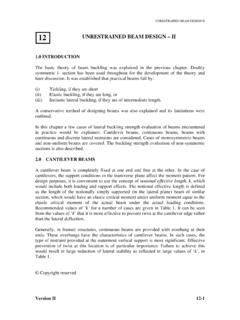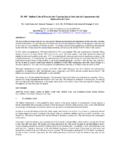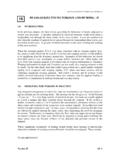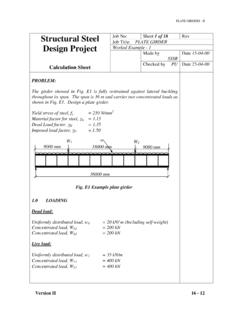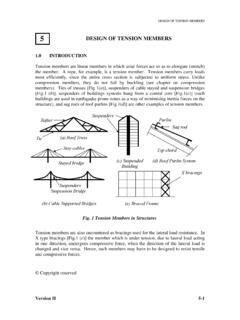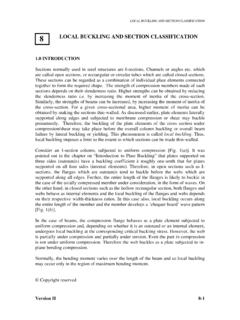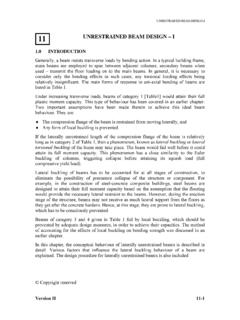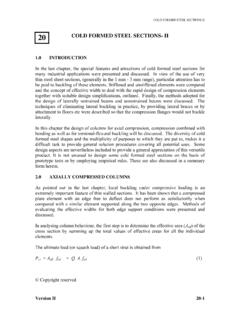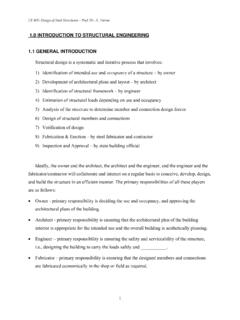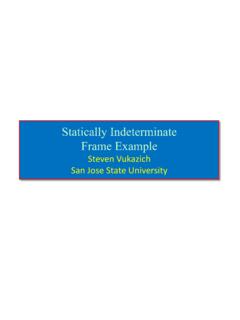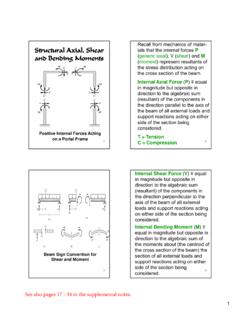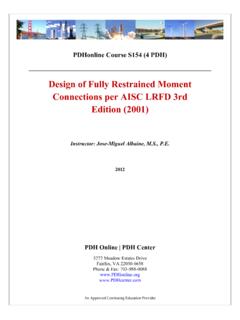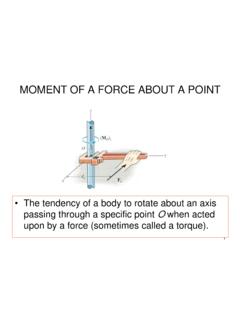Transcription of 43 STEEL BRIDGES - I
1 STEEL BRIDGES - I Version II 43 - 1 STEEL BRIDGES - I INTRODUCTION As discussed in earlier chapters the main advantages of structural STEEL over other construction materials are its strength and ductility. It has a higher strength to cost ratio in tension and a slightly lower strength to cost ratio in compression when compared with concrete. The stiffness to weight ratio of STEEL is much higher than that of concrete. Thus, structural STEEL is an efficient and economic material in BRIDGES . Structural STEEL has been the natural solution for long span BRIDGES since 1890, when the Firth of Forth cantilever bridge, the world's major STEEL bridge at that time was completed. STEEL is indeed suitable for most span ranges, but particularly for longer spans.
2 Howrah Bridge, also known as Rabindra Setu, is to be looked at as an early classical STEEL bridge in India. This cantilever bridge was built in 1943. It is 97 m high and 705 m long. This engineering marvel is still serving the nation, deriding all the myths that people have about STEEL . [See Fig. 1] The following are some of the advantages of STEEL BRIDGES that have contributed to their popularity in Europe and in many other developed countries. x They could carry heavier loads over longer spans with minimum dead weight, leading to smaller foundations. x STEEL has the advantage where speed of construction is vital, as many elements can be prefabricated and erected at site. Copyright reserved 43 Fig.
3 1 Howrah bridge STEEL BRIDGES - I Version II 43 - 2x In urban environment with traffic congestion and limited working space, STEEL BRIDGES can be constructed with minimum disruption to the community. x Greater efficiency than concrete structures is invariably achieved in resisting seismic forces and blast loading. x The life of STEEL BRIDGES is longer than that of concrete BRIDGES . x Due to shallow construction depth, STEEL BRIDGES offer slender appearance, which make them aesthetically attractive. The reduced depth also contributes to the reduced cost of embankments. x All these frequently leads to low life cycle costs in STEEL BRIDGES In India there are many engineers who feel that corrosion is a problem in STEEL BRIDGES , but in reality it is not so.
4 Corrosion in STEEL BRIDGES can be effect ively minimised by employing newly developed paints and special types of STEEL . These techniques are followed in Europe and other developed countries. These have been discussed in chapter 2. STEEL USED IN BRIDGES STEEL used for BRIDGES may be grouped into the following three categories: (i) Carbon STEEL : This is the cheapest STEEL available for structural users where stiffness is more important than the strength. Indian steels have yield stress values up to 250 N/mm2 and can be easily welded. The STEEL conforming to IS: 2062 - 1969, the American ASTM A36, the British grades 40 and Euronorm 25 grades 235 and 275 steels belong to this category.
5 (ii) High strength steels: They derive their higher strength and other required properties from the addition of alloying elements. The STEEL conforming to IS: 961 - 1975, British grade 50, American ASTM A572 and Euronorm 155 grade 360 steels belong to this category. Another variety of STEEL in this category is produced with enhanced resistance to atmospheric corrosion. These are called 'weathering' steels in Europe, in America they conform to ASTM A588 and have various trade names like ' cor-ten'. (iii) Heat-treated carbon steels: These are steels with the highest strength. They derive their enhanced strength from some form of heat-treatment after rolling namely normalisation or quenching and tempering.
6 The physical properties of structural STEEL such as strength, ductility, brittle fracture, weldability, weather resistance etc., are important factors for its use in bridge construction. These properties depend on the alloying elements, the amount of carbon, cooling rate of the STEEL and the mechanical deformation of the STEEL . The detailed discussion of physical properties of structural STEEL is presented in earlier chapter. STEEL BRIDGES - I Version II 43 - CLASSIFICATION OF STEEL BRIDGES STEEL BRIDGES are classified according to x the type of traffic carried x the type of main structural system x the position of the carriage way relative to the main structural system These are briefly discussed in this section.
7 Classification based on type of traffic carried BRIDGES are classified as x Highway or road BRIDGES x Railway or rail BRIDGES x Road - cum - rail BRIDGES Classification based on the main structural system Many different types of structural systems are used in BRIDGES depending upon the span, carriageway width and types of traffic. Classification, according to make up of main load carrying system, is as follows: (i) Girder BRIDGES - Flexure or bending between vertical supports is the main structural action in this type. Girder BRIDGES may be either solid web girders or truss girders or box girders. Plate girder BRIDGES are adopted for simply supported spans less than 50 m and box girders for continuous spans upto 250 m.
8 Cross sections of a typical plate girder and box girder BRIDGES are shown in Fig. 2(a) and Fig. 2(b) respectively. Truss BRIDGES [See Fig. 2(c)] are suitable for the span range of 30 m to 375 m. Cantilever BRIDGES have been built with success with main spans of 300 m to 550 m. In the next chapter girder BRIDGES are discussed in detail. They may be further, sub-divided into simple spans, continuous spans and suspended-and-cantilevered spans, as illustrated in Fig. 3. Fig. 2(a) Plate girder bridge section STEEL BRIDGES - I Version II 43 - 4 Fig. 2(c) Some of the trusses used in STEEL BRIDGES Varying depth warren truss Howe truss Pratt truss (a) Discontinuous span girder bridge Fig.
9 3 Typical girder BRIDGES (c) Suspended and cantilever span girder bridge (b) Continuous span girder bridge Girder Supports Fig. 2(b) Box girder Bridge section STEEL BRIDGES - I Version II 43 - 5(ii) Rigid frame BRIDGES - In this type, the longitudinal girders are made structurally continuous with the vertical or inclined supporting member by means of moment carrying joints [Fig. 4]. Flexure with some axial force is the main forces in the members in this type. Rigid frame BRIDGES are suitable in the span range of 25 m to 200 m. (iii) Arch BRIDGES - The loads are transferred to the foundations by arches acting as the main structural element. Axial compression in arch rib is the main force, combined with some bending.
10 Arch BRIDGES are competitive in span range of 200 m to 500 m. Examples of arch BRIDGES are shown in Fig. 5. (iv) Cable stayed BRIDGES - Cables in the vertical or near vertical planes support the main longitudinal girders. These cables are hung from one or more tall towers, and are usually anchored at the bottom to the girders. Cable stayed BRIDGES are economical when the span is about 150 m to 700 m. Layout of cable stayed BRIDGES are shown in Fig. 6. Fig. 4 Typical rigid frame bridge Fig. 5 Typical arch BRIDGES STEEL BRIDGES - I Version II 43 - 6 (v) Suspension BRIDGES - The bridge deck is suspended from cables stretched over the gap to be bridged, anchored to the ground at two ends and passing over tall towers erected at or near the two edges of the gap.

